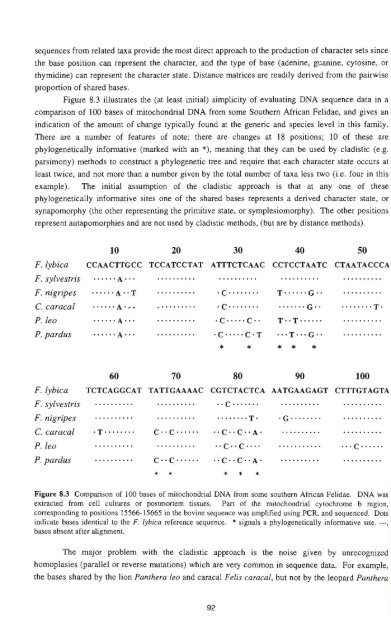CONSERVATION OF ARABIAN GAZELLES - Nwrc.gov.sa
CONSERVATION OF ARABIAN GAZELLES - Nwrc.gov.sa
CONSERVATION OF ARABIAN GAZELLES - Nwrc.gov.sa
You also want an ePaper? Increase the reach of your titles
YUMPU automatically turns print PDFs into web optimized ePapers that Google loves.
sequences from related taxa provide the most direct approach to the production of character sets since<br />
the base position can represent the character, and the type of base (adenine, guanine, cytosine, or<br />
thymidine) can represent the character state. Distance matrices are readily derived from the pairwise<br />
proportion of shared bases.<br />
Figure 8.3 illustrates the (at least initial) simplicity of evaluating DNA sequence data in a<br />
comparison of 100 bases of mitochondrial DNA from some Southern African Felidae, and gives an<br />
indication of the amount of change typically found at the generic and species level in this family.<br />
There are a number of features of note: there are changes at 18 positions; 10 of these are<br />
phylogenetically informative (marked with an *), meaning that they can be used by cladistic (e.g.<br />
parsimony) methods to construct a phylogenetic tree and require that each character state occurs at<br />
least twice, and not more than a number given by the total number of taxa less two (i.e. four in this<br />
example). The initial assumption of the cladistic approach is that at anyone of these<br />
phylogenetically infonnative sites one of the shared bases represents a derived character state, Or<br />
synapomorphy (the other representing the primitive state, or symplesiomorphy). The other positions<br />
represent autapomorphies and are not used by cladistic methods, (but are by distance methods).<br />
10 20 30 40 50<br />
F. lybica CCAACTTGCC TCCATCCTAT ATTTCTCAAC CCTCCTAATC CTAATACCCA<br />
F. sylvestris ...... A .. · ......... . .......... .......... . .........<br />
F. nigripes ...... A .. T .......... ·C .... • .. · T .. ·· .. G .. . .........<br />
C. caracal ...... A· •• -......... ·C· ...... · ...... ·G .. · .... · .. T·<br />
P. leo ...... A .. · .......... ·C .... ·C .. T .. T ...... ..........<br />
P. pardus ...... A .. · .......... ·C .... ·C·T .. ·T· .. G .. ...... ....<br />
* * * * *<br />
60 70 80 90 100<br />
F. lybica TCTCAGGCAT TATTGAAAAC CGTCTACTCA AATGAAGAGT CTTTGTAGTA<br />
F. sylvestris ......... . . ......... .. C .. · .... .......... .......... <br />
F. nigripes .......... .......... ........ T· · G .... · .. · .......... <br />
C. caracal ·T .. · .... · C .. C ...... "C"C"A' . . . . . . . . . . .......... <br />
P. leo ......... . .......... .. C .. C .... ........... ..·C...... <br />
P. pardus .......... C .. C ...... "C"C"A' .......... .......... <br />
• • • • •<br />
Figure 8.3 Comparison of 100 bases of mitochondrial DNA from some southern African Felidae. DNA was<br />
extracted from cell cultures or postmortem tissues. Pan of the mitochondrial cytochrome b region,<br />
corresponding to positions 15566-15665 in the bovine sequence was amplified using PCR, and sequenced. Dots<br />
indicate bases identical to the F. Iybica reference sequence. * signals a phylogenetically infonnative site. ---,<br />
bases absent after aligrunent.<br />
The major problem with the cladistic approach is the noise given by unrecognized<br />
homoplasies (parallel or reverse mutations) which are very commOn in sequence data. For example,<br />
the bases shared by the lion Panthera leo and caracal Felis caracal, but not by the leopard Panthera<br />
92
















